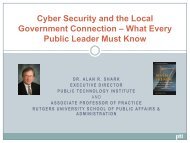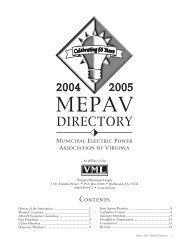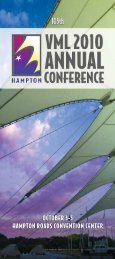Affordable Care Act - the Virginia Municipal League
Affordable Care Act - the Virginia Municipal League
Affordable Care Act - the Virginia Municipal League
Create successful ePaper yourself
Turn your PDF publications into a flip-book with our unique Google optimized e-Paper software.
community asset, one that not onlyhas economic and environmentalimplications, but also serves as a socialthread woven throughout <strong>the</strong> community.Mayor A.C. Wharton of Memphisprioritized <strong>the</strong> city’s waterfrontas a tool to reconnect neighborhoodsand people in a city:“In consideration of our localassets, we can never overlook ourprized riverfront. The riverfront ishome to our city’s ritual events andcelebrations, and common groundfor every citizen and every visitor.Because of this, I asked (Jeff) … tohelp me develop a balanced approachthat attracts people to <strong>the</strong> riverfrontwhile offering a menu of options toexplore and enjoy.”O<strong>the</strong>r mayors spoke more specificallyabout protecting <strong>the</strong>ir watershedsas a means to protect naturalresources and enhance quality of lifefor residents. For example, San DiegoMayor Filner spoke about a regionalconvening to address water scarcityin <strong>the</strong> Bay Delta, while Mayor PeteLewis of Auburn, Wash., describeda wetland expansion project on <strong>the</strong>local community college campus thatwill increase wetland capacity, filtertoxins in rainwater and improve waterquality.Richmond’s Mayor Jones aptlystated <strong>the</strong> role of water in a city’sfuture when he said, “We have plansdrawn that will connect <strong>the</strong> river’s useto downtown and remove pedestrianbarriers to ensure greater access.” Hewent on to describe <strong>the</strong> James Riveras “our precious gem,” a source ofpride for <strong>the</strong> whole city.Tying toge<strong>the</strong>r transit:Connecting citiesIn Somerville, Mass., MayorJoseph Curtatone spoke of <strong>the</strong> greenline (subway) extension as critical todriving public and private investmentin a historically disinvested area of <strong>the</strong>city: “For years, we’ve invested heavilyin West Somerville while <strong>the</strong> easternpart of our city soldiered on as a greatbut underfunded neighborhood. I amhere tonight to declare quite unequivocally,it’s East Somerville’s turn.” InRichmond, Atlanta and o<strong>the</strong>r cities,mayors similarly acknowledged <strong>the</strong>potential for transit to reduce povertyin particular neighborhoods, connectpeople to jobs, and provide transportationalternatives that are accessibleand affordable.These mayors and o<strong>the</strong>rs alsorecognized <strong>the</strong> important role oftransit in making <strong>the</strong>ir city an effectiveregional player. Mayor Lewisdescribed how Auburn has emergedas a central transit hub for <strong>the</strong> region,with four regional transit lines (andnumerous local ones) coming toge<strong>the</strong>rin <strong>the</strong> city. He went on to describe<strong>the</strong> implications of this in terms ofestablishing <strong>the</strong> city as a regionalhub for <strong>the</strong> education and healthcaresectors. In Durham, N.C., MayorBill Bell congratulated residents forapproving a half-cent sales tax inDurham and Orange County that willbe used to fund new bus and light railservices. With “providing efficient andfriendly transit services” as one of fivepriority areas he spoke of, Mayor Bellnot only emphasized <strong>the</strong> localbenefits of connecting peopleto jobs, shops and healthcareservices within <strong>the</strong> city,he also directly spoke to his partnersoutside city limits:“We must also remind ourneighbors to <strong>the</strong> east that we aretruly one interconnected regionthat is home to millions of peoplewho cross back and forth acrossall three counties each and everyday. Our transportation problemsare regional problems and we mustpartner toge<strong>the</strong>r on a regional basisto solve <strong>the</strong>se issues.”Buildingconnected citiesWhe<strong>the</strong>r mayors are focusing onimproving <strong>the</strong>ir streetscapes, connecting<strong>the</strong>ir transportation services,or enhancing <strong>the</strong>ir waterways, <strong>the</strong>State of <strong>the</strong> City addresses this yearmade it clear that infrastructureimprovements and investments serveas an important tool whereby localgovernments are both responding tocitizen’s immediate needs (e.g. fillingpotholes) and also working with localand regional partners to envision andimplement an alternate future thatprioritizes increased quality of life forall residents. Despite scarce resources(and <strong>the</strong> possible removal of <strong>the</strong>municipal bond tax exemption),mayors recognize and are committedto infrastructure investments as apriority strategy to create a connectedcity.About <strong>the</strong> authorRaksha Vasudevan is a sustainability associateat <strong>the</strong> National <strong>League</strong> of Cities. Thiswas <strong>the</strong> fifth in a series of seven blog postson trends and <strong>the</strong>mes in local leadership.<strong>Virginia</strong> Town & City | april 2013 13









